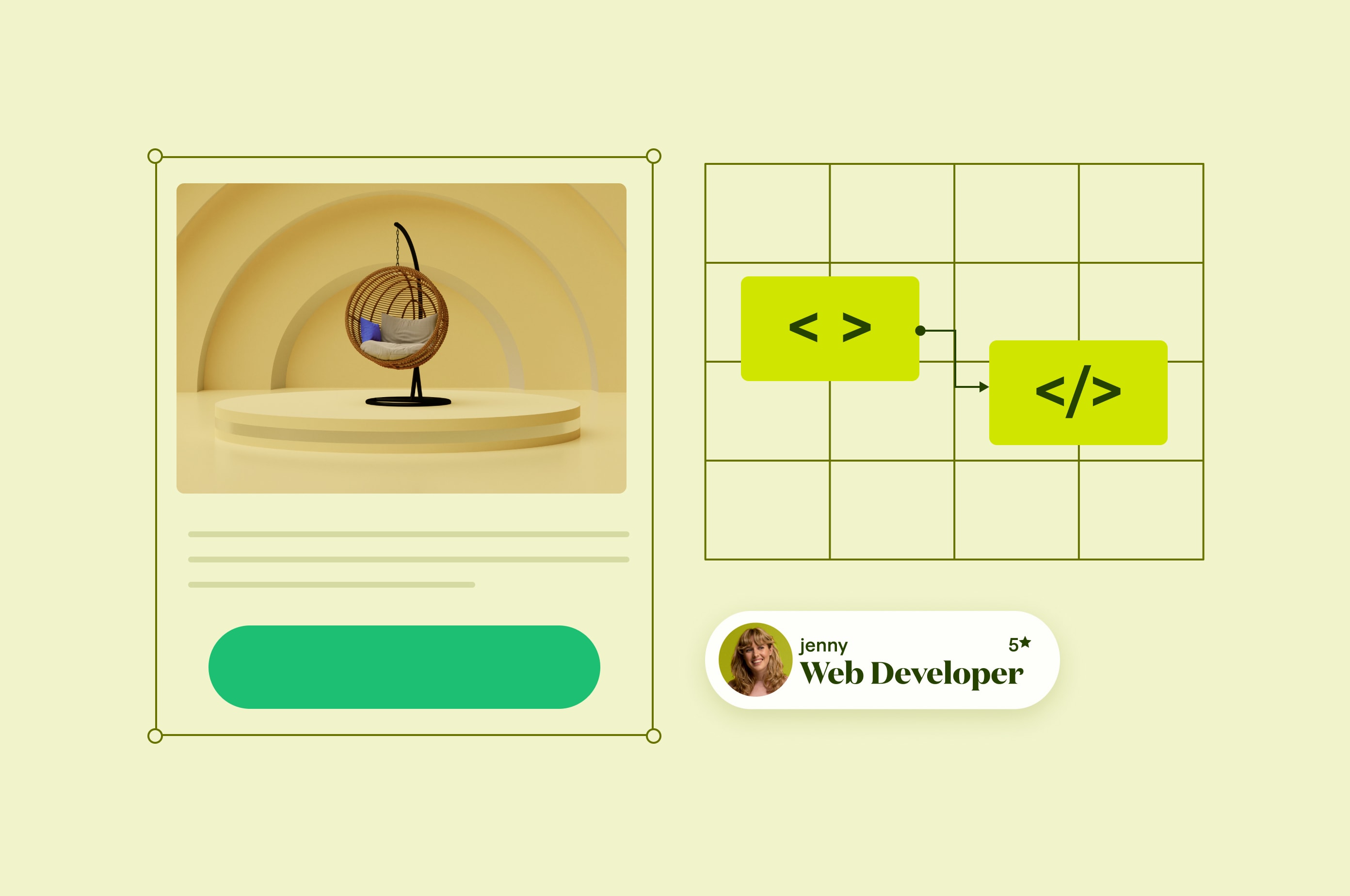Corporate Website Design: Expert Tips, Costs, Examples + Checklist
A well-designed corporate website can help you attract new customers, establish credibility, and drive conversions. Here’s how to ensure your corporate website design is a success.
 April 11, 2024
April 11, 2024 10 minute reading
10 minute reading
Corporate website design has become an essential aspect of modern business. In fact,Research shows that half (50%) of online consumers believe a business's website design plays a significant role in shaping their opinion of that brand.
In today's digital age, your website serves as the face of your company, making it crucial to create a strong online presence. A well-designed corporate website can attract and retain customers, establish credibility, and drive conversions.
To unlock the power of corporate website design, we compiled expert tips and examples that’ll transform your online presence. Whether you’re designing a new website or revamping an existing one, these insights will guide you toward success.
Hire a web designer on Fiverr
Why is corporate webpage design important?
Your corporate website is a primary tool for driving traffic, generating leads, and converting visitors into customers. It’s often the first point of contact for potential customers and sets the tone for their overall perception of your brand.
Through thoughtful design choices, such as color palettes, typography, and imagery, you can create a cohesive and visually appealing representation of your company. A well-designed corporate website can make a lasting impression, convey professionalism, and instill trust. This establishes a strong brand presence and fosters a sense of familiarity and recognition among your target audience.
What separates corporate site design from other types of websites?
While the principles of good site design apply to many websites, corporate website design has unique considerations. Unlike personal blogs or e-commerce websites, a corporate website homepage is the central hub for a company's online presence. It often has specific objectives, such as lead generation or brand building.
Corporate websites typically have a more professional and formal tone compared to other types of websites. They often include additional features, such as investor relations pages, career opportunities, or press releases. These sections require special attention to ensure the design is cohesive, user-friendly, and effectively conveys the desired information.
What are the key elements of successful corporate web design?
A successful corporate website design results from careful planning and attention to detail. There are many key elements that contribute to an effective business website design.
These include:
Branding and visual consistency
Consistency in design elements—branding colors, fonts, and imagery—creates a cohesive and professional look. It establishes brand recognition and makes your website visually appealing. Branding plays a pivotal role in corporate website design. Your website should reflect your company's brand identity, values, and personality.
Engaging content
Compelling content captures visitors' attention and keeps them engaged. Use a mix of text, visuals, and multimedia to convey your message effectively and provide valuable information to your audience.
Intuitive navigation
Make it easy for users to find what they're looking for by implementing clear and intuitive navigation. Use descriptive labels, concise menus, breadcrumbs, and search functionality to help users find what they're looking for easily, as well as a logical page hierarchy to guide users through your website.
Clear calls to action
Well-placed and persuasive CTAs encourage visitors to take desired actions, such as making a purchase, signing up for a newsletter, or requesting a quote. Ensure your CTAs stand out visually and use persuasive copy to encourage visitors to take the next step.
Page load speed
Optimizing your website's load speed offers a positive user experience. Minimize the use of large files, optimize images, and leverage caching techniques to ensure fast-loading pages.
Mobile-friendly design
As of December 2023, more than half (56.1%) of all web traffic came via mobile phones. So, implement responsive design to ensure your website looks and functions well on smartphones and tablets. Optimizing your website for mobile devices will allow faster load times, reducing bounce rates and increasing user engagement.
Accessible design
Make your website accessible to users with disabilities by following web accessibility standards. Consider factors such as color contrast, alternative text for images, and keyboard navigation.
Lead capture forms
Design your lead capture forms to be visually appealing, user-friendly, and aligned with your brand. Keep the form fields to a minimum, use clear labels and instructions, and consider using interactive form elements to enhance the user experience.
Trust signals
Include trust signals such as customer testimonials, client logos, and security badges to instill trust and credibility. These signals reassure visitors they’re making the right choice by engaging with your company. Testimonials and case studies can build trust and persuade visitors to become customers.
Social media integration
Integrate social media buttons and sharing options into your business website design. This allows visitors to share your content on social platforms, which can increase your reach and drive traffic to your website. Engage with your audience on social media to build a loyal community that actively promotes your brand.
Blogging and content marketing
Create a blog section on your corporate website to publish informative and engaging content regularly. Providing valuable content addressing your audience's pain points can attract organic traffic, establish thought leadership, and position your company as a trusted resource.
What are the top tips for creating a visually appealing corporate website design?
Creating a visually appealing corporate website design requires a combination of artistic flair and strategic thinking. Here are expert tips to bring your corporate website design to life.
Understand your brand
Before diving into the design process, take time to understand your brand identity and values. This will guide your design decisions and ensure consistency with your overall brand image.
Choose the right color palette
Colors evoke emotions and play a crucial role in your website's visual impact. Select a color palette that aligns with your brand personality and resonates with your target audience.
Use high-quality imagery
Invest in professional photography or high-quality stock images to enhance the visual appeal of your website. Avoid using generic or low-resolution images that detract from your brand's credibility.
White space is your friend
Don't overcrowd your website with excessive content or design elements. Embrace white space to create a clean and organized layout that allows your content to breathe and makes it easier for users to digest information.
Typography matters
Choose fonts that are legible and reflect your brand's personality. Consider using a combination of fonts to create visual hierarchy and guide users' attention to important elements.
Optimize load times
Slow-loading websites can frustrate users and lead to high bounce rates. Optimize your website's performance by compressing images, minifying code, and leveraging caching techniques.
Brand storytelling
Take advantage of storytelling techniques to humanize your brand and connect with your audience emotionally. Share your company's journey, values, and success stories through engaging narratives. By weaving storytelling into your website design, you’ll create a memorable and authentic brand experience.
What are the most common mistakes to avoid in corporate website design?
It’s essential to know what to include in your business website design, but it’s equally important to know common mistakes to avoid. Here are some pitfalls you should steer clear of.
Complex navigation
Avoid overwhelming visitors with too many menu options or convoluted dropdowns. Instead, aim for a clear and intuitive navigation structure.
Slow loading speed
Optimize your website by compressing images, minifying code, and using caching techniques to ensure a swift and seamless user experience.
Lack of clear call-to-actions (CTAs)
Without clear CTAs, visitors may struggle to understand the next steps or actions to take on the website. This confusion can lead to a lack of engagement, poor conversion rates, and missed business opportunities, since users might not know how to proceed or where to find relevant information.
What can you learn from the top corporate website designs?
To gain a better understanding of what makes a business’s website design successful, let's look at examples of the best corporate websites.
Apple
Known for its minimalist and clean design, Apple's company website perfectly reflects the company's brand identity. It uses clean lines, high-quality visuals, and simple navigation to create an elegant and user-friendly experience.

Nike
Nike's corporate website is a testament to the power of storytelling. Through captivating visuals, videos, and interactive elements, Nike engages its audience and conveys its brand message effectively.

Airbnb
Airbnb's corporate website is a prime example of a great user experience. The intuitive search functionality, personalized recommendations, and visually appealing listings make it easy for users to find and book accommodations.

By studying successful websites in your own industry, you can gather further inspiration and apply similar strategies to enhance your own company website design.
What corporate website design trends will be on the rise in 2024?
Staying up-to-date with the latest trends ensures your corporate website remains fresh and engaging. Here are the trends to watch out for in corporate website design:
Immersive user experiences: By incorporating interactive elements like animations, micro-interactions, and 3D graphics, users can enjoy a more captivating and unforgettable experience.
Augmented reality (AR) and virtual reality (VR): The integration of AR and VR features can create immersive experiences, particularly in real estate, education, or retail. Users can now visualize products or spaces in a new way.
Voice user interface (VUI): As voice-activated devices continue to rise in popularity, incorporating voice user interfaces into corporate websites is becoming common. This provides users with alternative and convenient methods of interaction.
Microcopy and conversational design: The use of thoughtful and concise microcopy, combined with conversational design principles, can significantly improve how organic and user-friendly interactions are.
What role is AI playing in corporate website design?
AI is impacting the efficiency of the website design process and the overall user experience in several ways. Here are some key areas where AI is making a significant impact.
Automated design and personalization
Layout generation: AI algorithms can analyze content and autonomously generate aesthetically pleasing and user-friendly layouts or templates.
Color schemes: AI tools can suggest and generate color palettes based on content and design objectives, streamlining the design process.
User behavior analysis: AI algorithms analyze user behavior and preferences to personalize content and design elements, providing a tailored experience for each visitor.
Dynamic content: AI-driven systems dynamically adjust content based on user preferences and location, ensuring a more engaging and relevant experience.
Adaptive layouts: AI helps create adaptive and responsive templates that seamlessly adjust across various devices, optimizing the user experience on desktop and mobile platforms.
Chatbots, virtual assistants, and VUI
User engagement: AI-powered chatbots and virtual assistants enhance user engagement by providing instant responses, guiding users, and offering personalized recommendations.
Voice-activated interfaces: AI facilitates the integration of voice-controlled interfaces, providing an alternative and accessible way for users to interact with websites.
Content creation and SEO
Automated copywriting: AI tools aid in generating compelling and relevant website content, reducing manual content creation efforts.
SEO optimization: AI can analyze and optimize website content for search engines, improving SEO performance by suggesting keywords and meta tags.
What is the cost of designing a corporate website (freelancer, agency & in-house)?
When designing a custom website for your business, you have three main options: hiring a freelance website designer, using a web design agency, or building an in-house team. Here's a breakdown of each option.
In-house team
Building an in-house team to handle your corporate website design is more expensive in terms of salaries, benefits, and overhead costs. You must also consider the time and resources required to recruit and manage a team. This makes an in-house team a better consideration for larger companies with complex corporate website requirements, as opposed to a small business.
Web design agency
According to Forbes, a corporate website of up to 75 pages can cost anywhere from $10,000 to $35,000 when designed, coded, and maintained by a third-party web design company.
The cost of hiring a web design agency to create a corporate website can vary significantly based on several factors. However, including the scope of the project, the level of customization, the agency's reputation, and its location.
Freelancer
Hiring a freelance website designer can be cost-effective, especially for small to medium-sized businesses. Freelancers often charge by the hour or offer fixed-price packages for website design. The cost will depend on the freelancer's experience, expertise, and the scope of your project. Typically, a corporate website can cost around $300 when hiring freelance web designer services.
Design and launch your own corporate website today
Unlocking the power of corporate website design is essential for establishing a strong online presence.
For professional assistance with your corporate website design needs, consider using Fiverr to find talented and knowledgeable experts. Let your website reflect your company's excellence and watch it elevate your online presence to new heights.
Ready to hire the right freelance web designer for your corporate website? Sign up for Fiverr today.



